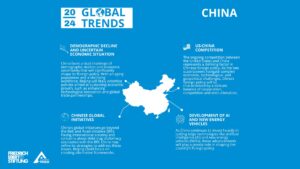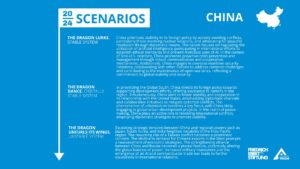In the ever-evolving landscape of global politics, maintaining stability may remain crucial. For the international system to remain stable and to ensure further growth of the Chinese People’s Republic, it is essential that Chinese policy aligns with critical global trends.
Through the prism of Ukrainian interests
KEY INDICATORS

The key indicators that will have an impact on the Chinese foreign and domestic policies as well as on the Chinese positioning in the global international system will be:
- The demographic situation in China: the demographic decline is an ongoing trend despite the rejection of the “one-child policy”. This trend may influence the economic situation, although the direct results of the respective impact will not be significant in the short-term period and can be compensated by the robotization of production, focus on services and new technologies, and stipulation of the economics by state subsidies.
- Deploying artificial intelligence (AI) in various sectors, including digital trade, will raise the issue of the respective regulations in China and globally. The subsidies for developing and adopting New Energy Vehicles to maintain Chinese dominance in lithium-ion battery production and addressing potential risks related to battery technology, such as safety and environmental concerns, will also remain a key priority.
- Development of Chinese global and regional initiatives. The Belt and Road Initiative (BRI) will remain among the Chinese priorities. However, China may refocus its financial flows on less global and regionally tailored initiatives, e.g. the Global Security Initiative and the Global Development Initiatives. Although judging from the names of both initiatives, they still contain a global element, their efficiency is mostly tested on the regional level (particularly in South East Asia). Instead of global projects worth hundreds of billions of dollars, the Chinese government rather tests smaller projects labelled as “small and beautiful”. Besides, China switches its “modus operandi” from state and private loans to grants usually managed by the MFA. However, the BRI won’t be neglected. Instead, the flow of capital may decrease. The initiative will still attract the attention of certain states due to the lack of alternatives and quite underdeveloped US-European Build Back Better World (B3W) Initiative and the Global Gateway Initiative.
- Competition in the high-technology domain will also remain trending. It will be one of the key drivers of competition between China, the United States and the West in general. The existing tensions, supplemented with the ideological discrepancy, may have spillover effects and result in the growth of tensions. Therefore, the proactive crisis prevention and management issue will remain high on the agenda.
- Competition with the United States and Washington’s Chinese strategy, as well as the Chinese approach towards Taiwan, will be a critical trend-making factor for the further evolution of Chinese policies, decisive for the next few years, and will pre-define the future of the international system.
SCENARIOS

STABLE SYSTEM. THE DRAGON LURKS
In the ever-evolving landscape of global politics, maintaining stability may remain crucial. For the international system to remain stable and to ensure further growth of the Chinese People’s Republic, it is essential that Chinese policy aligns with critical global trends.
Though stillborn in its current form, the Global Security Initiative announced in 2022 may set an essential foundation for Chinese engagement. While not directly linked to the Global Development Initiative, the core principle that a nuclear war cannot be won and should not be initiated will continue to guide China’s approach to global politics. This commitment to avoiding nuclear conflicts may foster stability and promote peaceful solutions.
Amidst growing tensions in the semiconductor industry, the red lines won’t be crossed, and monopolies won’t be established. China’s commitment to competition without confrontation may ensure a vibrant and innovative semiconductor market.
China’s Belt and Road Initiative, the Build Back Better World Initiative, and the Global Gateway Initiative will compete fairly while complementing each other. This cooperative approach encourages collaboration and fosters mutual benefits, enhancing stability and economic growth in regions involved in these initiatives.
Deploying AI in various sectors, including digital trade, will be subject to regulation. China will recognize the importance of using AI for competition rather than confrontation.
The United States and China will also recognize the importance of proactive crisis prevention and management. By continuously updating and improving their protocols, both nations can effectively address potential conflicts and avoid unexpected escalations. This commitment to clear communication and mutual understanding contributes to stability and minimises the risk of miscalculations.
In addition to the aforementioned areas of alignment, if China coordinates its efforts in overseas maritime security with other interested actors, such as the United Nations (UN), the European Union (EU), and the North Atlantic Treaty Organization (NATO), it can bring added value and enhance the security of crucial regions like the Gulf of Guinea, the Horn of Africa, and Somalia.
By actively participating in multinational efforts to combat piracy and ensure maritime security, China may demonstrate its commitment to being a responsible global actor. Cooperation among nations in addressing piracy not only safeguards vital trade routes but also promotes stability and economic development in these regions. China’s involvement can contribute resources, expertise, and naval assets to complement the existing efforts and enhance the effectiveness of joint operations.
China’s engagement in overseas maritime security, in concert with other interested actors, may strengthen regional stability, protect vital shipping lanes, and mitigate the threat of piracy. This collective effort benefits China and enhances the security and prosperity of the entire international community.
By embracing this collaborative approach, China can position itself as a valuable contributor to global security, fostering goodwill among nations and reinforcing its commitment to a stable international system.
ORBITALLY STABLE SYSTEM. THE DRAGON DANCE
China’s Global Development Initiative and Global Security Initiative are likely to continue as essential components of Chinese foreign policy. While these initiatives may not be options for Asian states in terms of military or traditional security cooperation, they could serve as supplementary instruments in non-military and non-traditional areas such as law enforcement operations and nuclear non-proliferation. China may emphasise these areas of cooperation to foster stability and mutual understanding.
Rather than developing separately, China’s Global Security Initiative and Global Development Initiative could be integrated into the implementation plan of the UN 2030 Agenda for Sustainable Development. This integration may involve focusing on the Global South, where China could assist and support sustainable development efforts. By aligning its initiatives with the UN agenda, China may contribute to global stability.
China will restrain and avoid any escalation on the Taiwan issue, regardless of the election outcomes in Taiwan. This approach aims to maintain regional stability and prevent conflicts that could disrupt the overall international system. China’s emphasis on peaceful resolution and dialogue regarding Taiwan will demonstrate its commitment to stability and a peaceful rise on the global stage, at least for a short period.
Bearing in mind the trend-setting factor of the US-China relations, both China and the United States are likely to avoid further escalations in their bilateral relations. China will showcase reliable self-restraint, focusing on crisis prevention and management protocols. By adopting a responsible and measured approach, China seeks to foster stability and maintain a cooperative relationship with the United States. This restraint is crucial for the orbital stability of the international system, as any major conflicts or tensions between these two global powers could have significant repercussions.
Relative normalisation in international relations can create a fruitful ground for economic growth. Improved diplomatic relations and reduced geopolitical tensions can foster increased trade, investment, and cooperation among nations. As a major global economic power, China can leverage this environment to further stimulate its economic growth.
As economic growth accelerates, urbanisation can gather pace as well. China has been undergoing rapid urbanisation, and this trend could be further amplified in a scenario of relative normalisation. China might focus on creating smart mega-cities to support sustainable and efficient urban development. These cities would utilise advanced technologies, data-driven infrastructure, and innovative solutions to enhance the quality of life for residents, promote environmental sustainability, and optimise resource management.
China will also dedicate significant efforts to resolving international issues, focusing on conflicts like the Israeli-Arab conflict and security challenges in Iraq, Libya, Sudan, and Yemen. Through diplomatic initiatives and active engagement in peacekeeping endeavours, China strives to establish itself as a responsible and constructive global actor, building a positive image on the world stage.
Meanwhile, China will actively pursue maritime dominance in the Southeast Asian region, employing a multifaceted strategy comprising military presence, strategic partnerships, and economic influence. Through the projection of maritime power, China ensures the safeguarding of its overseas interests, notably securing vital trade routes.
Demonstrating unwavering commitment, the central government will continue to subsidise the development and adoption of New Energy Vehicles. Concurrently, China strives to maintain its dominance in lithium-ion battery production – an indispensable component of NEVs – by intensifying investments in research and development.
A transformational shift in the China-Russia dialogue sees the “no limits” narrative of the past fading away. Embracing a more nuanced approach, both nations foster constructive dialogue and reinforce cooperation. Though, hina’s adoption of a less confrontational “wolf-warrior” rhetoric will signal a preference for diplomacy and cooperation on the international stage.
As China’s economy reaches a more stable plateau after rapid growth, a deliberate focus on sustainability and environmental responsibility may take precedence.
China’s orbitally stable system development scenario revolves around a balanced and pragmatic approach to international affairs. Through concerted efforts in conflict resolution, technological advancements, maritime prowess, clean energy, and constructive diplomacy, China will seek to bolster its positive image and global influence while fostering economic stability and sustainable development at home.
UNSTABLE SYSTEM. THE DRAGON UNFURLS ITS WINGS
Amid mounting geopolitical tensions, China may seize the opportunity to propose its Global Security Initiative (GSI) as an alternative to the US-led or US-dominated security mechanisms. The GSI gradually gains momentum, attracting support from other nations dissatisfied with the existing security arrangements. This shift leads to a fragmented and less effective international security landscape, with nations aligning with the GSI or traditional security mechanisms.
The Global Development Initiative undergoes transformation into an alternative to the American B3W Initiative and the European Global Gateway Initiative. China leverages the GDI to assert greater control over global industrial supply chains, directing investments and resources to strengthen its economic influence. This move further intensifies economic competition and geopolitical rivalries among major powers.
In the aftermath of the January 2024 elections in Taiwan, where results do not align with Beijing’s interests, tensions escalate. China perceives the outcome as a challenge to its territorial claims, leading to increased military manoeuvres and a semi-conductor trade war. The region becomes a focal point of instability, affecting global supply chains and economic interdependence.
Growing strategic tensions between China and regional powers like Japan, South Korea, and India exacerbate instability in the Indo-Pacific region. Military modernisation efforts in China and the US-Australia-Japan triangle fuel an arms race, heightening security concerns globally. This dangerous escalation strains diplomatic relations and heightens the risk of conflict.
China invests heavily in cultural expansion to consolidate its soft power and influence. Drawing on Russian know-how in information warfare, China constructs alternative reality patterns through sophisticated disinformation campaigns, influencing global narratives to its advantage.
As tensions rise and demand for Chinese exports declines in the West due to geopolitical uncertainties, China shifts its focus towards the Global South. This pivot involves increased economic cooperation, investments, and infrastructure projects to secure new markets and partners.
Amid the unstable international system, China and Russia’s alliance strengthens further. The two nations coordinate media strategies to amplify their shared narratives and challenge the dominant information dissemination models in the West. This coordination enhances their geopolitical influence and seeks to reshape the global information landscape.
The critically unstable international system outlined in this scenario is characterised by growing geopolitical tensions, economic rivalries, and military build-ups. China’s assertive moves, such as promoting the GSI and GDI, exacerbate divisions among nations, leading to a fragmented security and development landscape. The escalating situation in the Indo-Pacific region compounds the instability, setting the stage for a precarious global environment.
The views expressed in this publication are not necessarily those of the Friedrich-Ebert-Stiftung or of the organization for which the author works.



